President Ma Ying-jeou (馬英九) yesterday reiterated his call on the US to sell F-16C/D aircraft to Taiwan during a meeting with American Institute in Taiwan (AIT) Chairman Raymond Burghardt and emphasized the importance of maintaining a balance of military strength across the Taiwan Strait.
The procurement of weapons conforms to the Taiwan Relations Act, Ma said, adding that the fighter aircraft would replace an aging fleet and would only be used for defensive purposes.
“The defense budget failed to reach 3 percent of GDP, but that budget is still more than the budget for last year ... The government will continue efforts to make sure the budget for national defense meets demands,” Ma said at the Presidential Office.
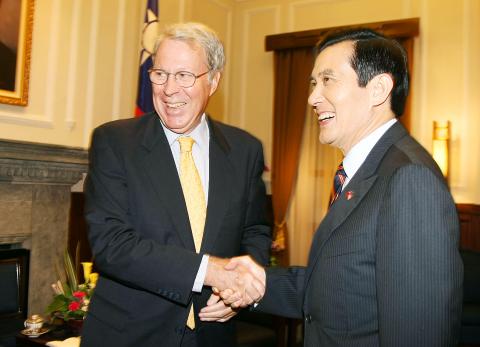
Photo: CNA
According to official figures, the defense budget last year was NT$297.4 billion (US$9.3 billion), compared with NT$297.2 billion this year. However, when asked for clarification, the Presidential Office told the Taipei Times that once subsidies for veterans’ housing and other expenditures not directly related to defense were factored in, the total budget for this year was NT$374.8 billion.
Burghardt, who arrived in Taipei on Sunday for a five-day visit, remained noncommittal on the 66 F-16C/Ds requested by Taipei and said he “didn’t come this time with any kind of special message from Washington.”
In his meeting with Democratic Progressive Party Chairperson Tsai Ing-wen (蔡英文) on Monday, Burghardt said that arms sales to Taiwan would continue, while describing the fighter aircraft sale as “an old subject.”
Ma, who said Washington has remained unwilling to accept a letter of request for the F-16C/Ds, thanked the US for releasing two arms procurement packages in 2008 and last year — both leftovers from former US president George W. Bush’s administration — to help Taiwan maintain its necessary defense capabilities.
Ma also thanked the US for assisting in Taiwan’s plan to join the International Civil Aviation Organization, saying air travel was becoming increasingly important now that the number of weekly cross-strait flights has increased from 370 to 558.
He also pointed to what he referred to as achievements in improving cross-strait relations and said the two sides would address issues such as investment protection, a dispute-resolution mechanism and nuclear security in cross-strait negotiations later this year.
Commenting on January’s presidential and legislative elections, Burghardt said the AIT congratulated Taiwan for its success in developing a real democracy and said that the US remained neutral on Taiwan’s elections.
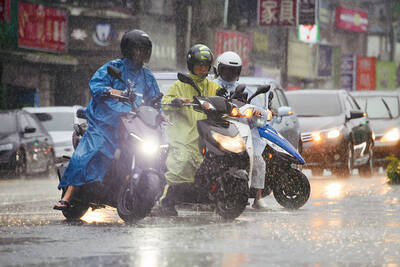
The combined effect of the monsoon, the outer rim of Typhoon Fengshen and a low-pressure system is expected to bring significant rainfall this week to various parts of the nation, the Central Weather Administration (CWA) said. The heaviest rain is expected to occur today and tomorrow, with torrential rain expected in Keelung’s north coast, Yilan and the mountainous regions of Taipei and New Taipei City, the CWA said. Rivers could rise rapidly, and residents should stay away from riverbanks and avoid going to the mountains or engaging in water activities, it said. Scattered showers are expected today in central and
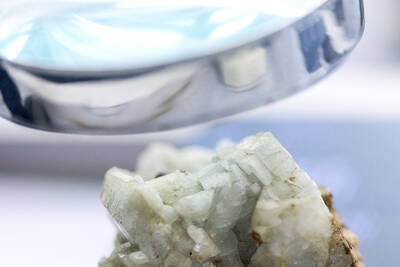
COOPERATION: Taiwan is aligning closely with US strategic objectives on various matters, including China’s rare earths restrictions, the Ministry of Foreign Affairs said Taiwan could deal with China’s tightened export controls on rare earth metals by turning to “urban mining,” a researcher said yesterday. Rare earth metals, which are used in semiconductors and other electronic components, could be recovered from industrial or electronic waste to reduce reliance on imports, National Cheng Kung University Department of Resources Engineering professor Lee Cheng-han (李政翰) said. Despite their name, rare earth elements are not actually rare — their abundance in the Earth’s crust is relatively high, but they are dispersed, making extraction and refining energy-intensive and environmentally damaging, he said, adding that many countries have opted to
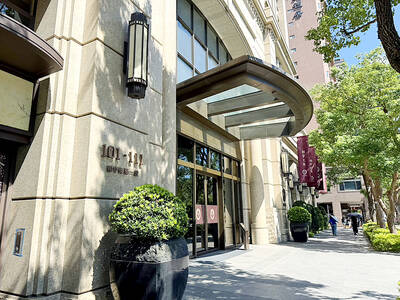
FORCED LABOR: A US court listed three Taiwanese and nine firms based in Taiwan in its indictment, with eight of the companies registered at the same address Nine companies registered in Taiwan, as well as three Taiwanese, on Tuesday were named by the US Department of the Treasury’s Office of Foreign Assets Control (OFAC) as Specially Designated Nationals (SDNs) as a result of a US federal court indictment. The indictment unsealed at the federal court in Brooklyn, New York, said that Chen Zhi (陳志), a dual Cambodian-British national, is being indicted for fraud conspiracy, money laundering and overseeing Prince Holding Group’s forced-labor scam camps in Cambodia. At its peak, the company allegedly made US$30 million per day, court documents showed. The US government has seized Chen’s noncustodial wallet, which contains
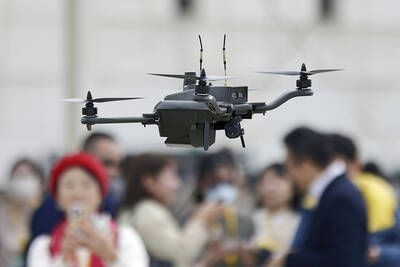
SUPPLY CHAIN: Taiwan’s advantages in the drone industry include rapid production capacity that is independent of Chinese-made parts, the economic ministry said The Executive Yuan yesterday approved plans to invest NT$44.2 billion (US$1.44 billion) into domestic production of uncrewed aerial vehicles over the next six years, bringing Taiwan’s output value to more than NT$40 billion by 2030 and making the nation Asia’s democratic hub for the drone supply chain. The proposed budget has NT$33.8 billion in new allocations and NT$10.43 billion in existing funds, the Ministry of Economic Affairs said. Under the new development program, the public sector would purchase nearly 100,000 drones, of which 50,898 would be for civil and government use, while 48,750 would be for national defense, it said. The Ministry of